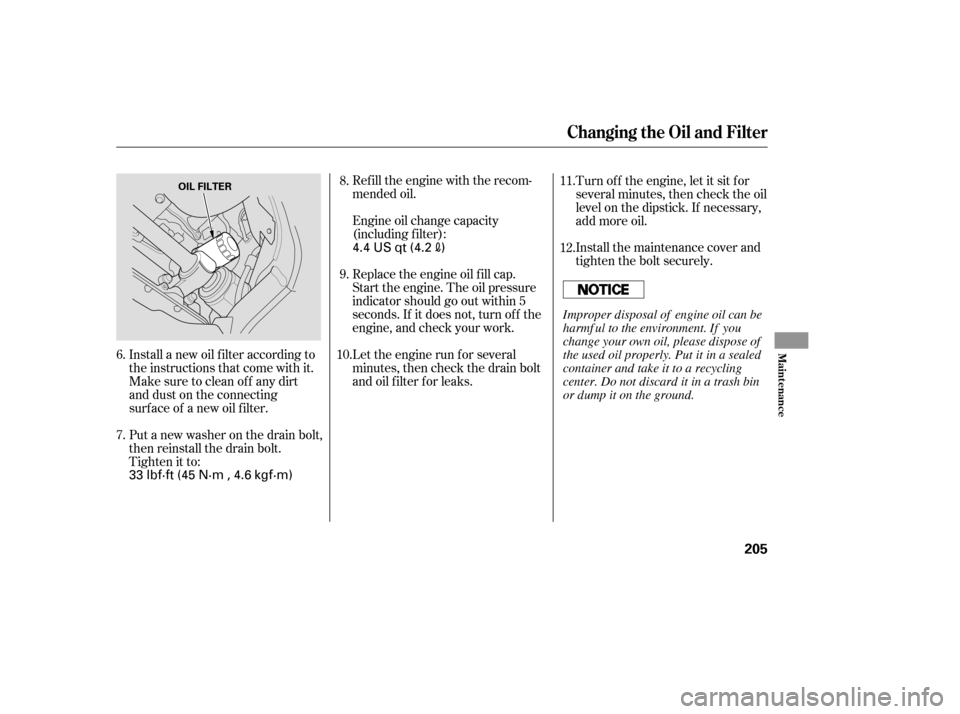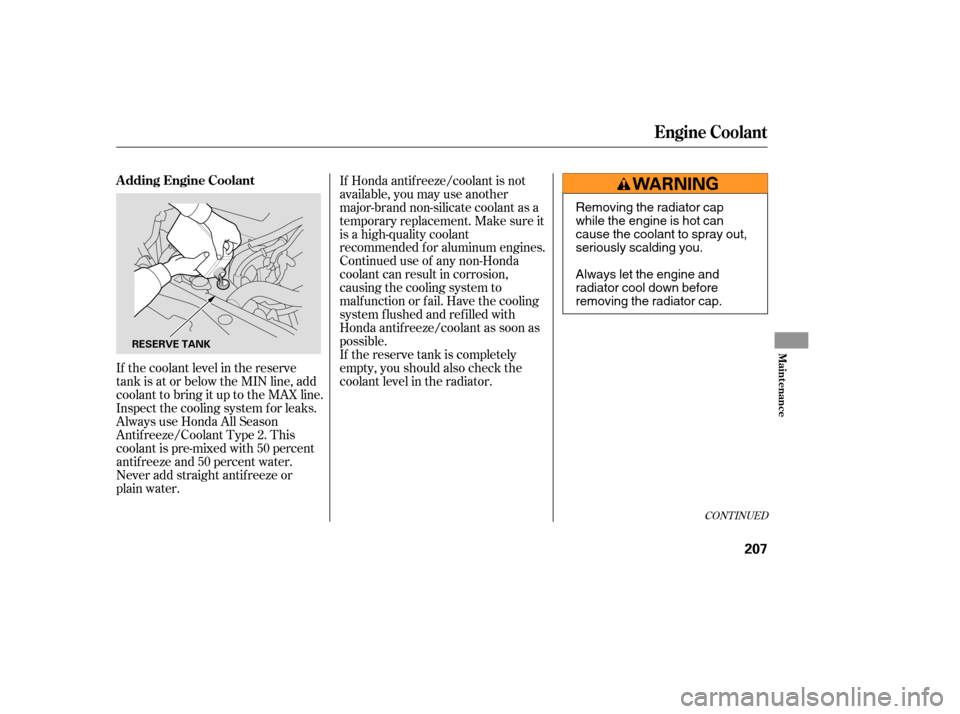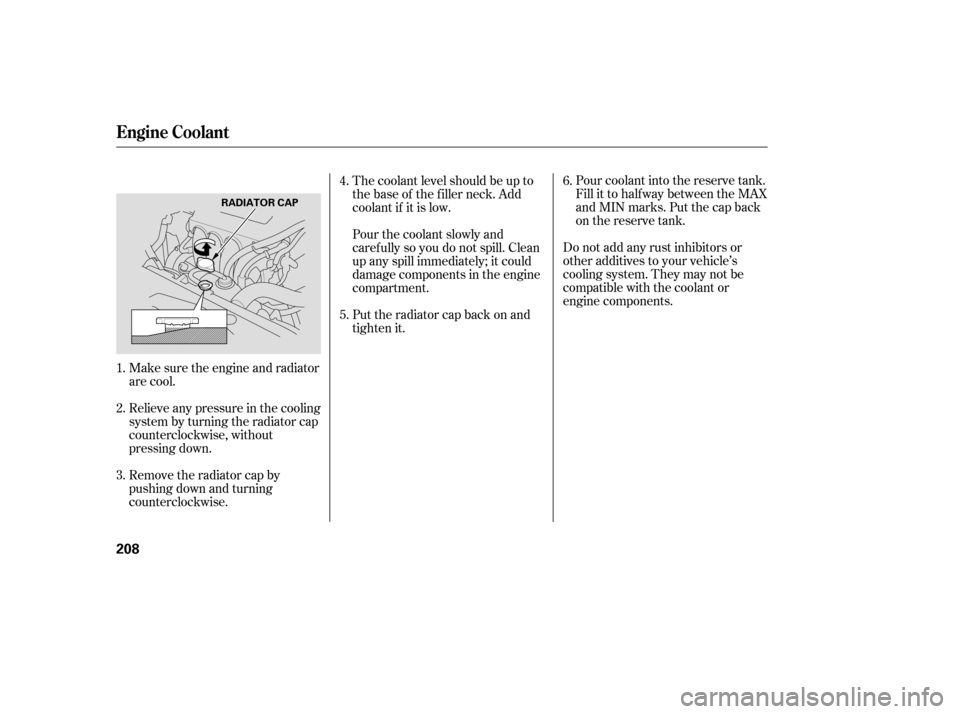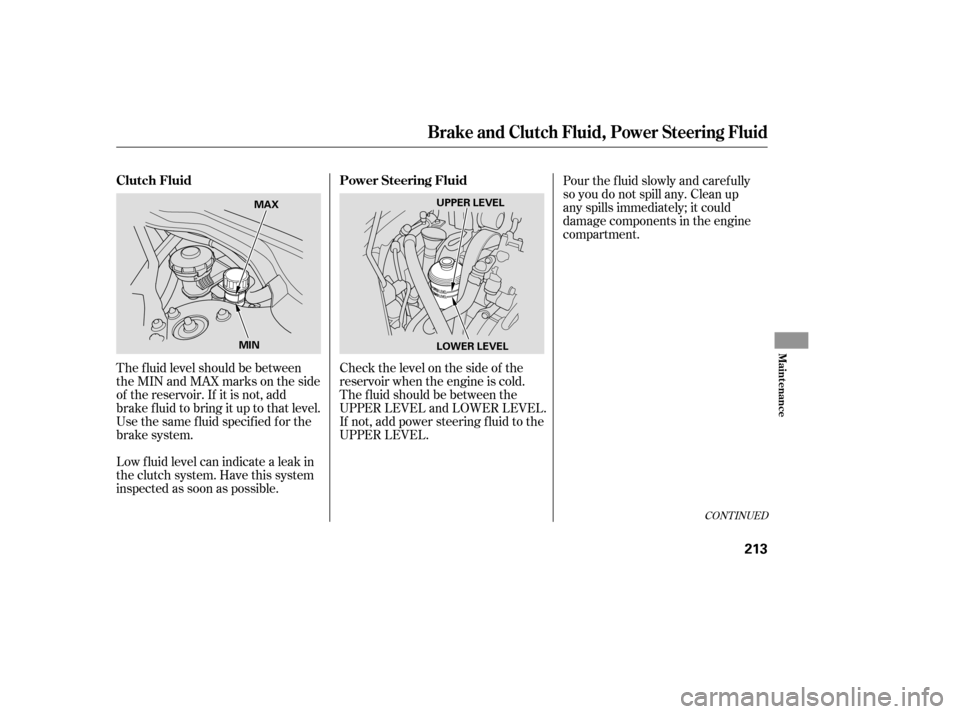engine Acura TSX 2005 Workshop Manual
[x] Cancel search | Manufacturer: ACURA, Model Year: 2005, Model line: TSX, Model: Acura TSX 2005Pages: 288, PDF Size: 4.14 MB
Page 206 of 288

Install a new oil f ilter according to
the instructions that come with it.
Put a new washer on the drain bolt,
then reinstall the drain bolt.
Tighten it to: Make sure to clean of f any dirt
and dust on the connecting
surf ace of a new oil f ilter.Refill the engine with the recom-
mended oil.
Engine oil change capacity
(including f ilter):
Replace the engine oil f ill cap.
Start the engine. The oil pressure
indicator should go out within 5
seconds. If it does not, turn of f the
engine, and check your work.
Let the engine run f or several
minutes, then check the drain bolt
and oil f ilter f or leaks.
Turn of f the engine, let it sit f or
several minutes, then check the oil
level on the dipstick. If necessary,
add more oil.
Install the maintenance cover and
tighten the bolt securely.
9. 8.
7. 6. 10. 12. 11.
Changing the Oil and Filter
Maint enance
205
OIL FILTER
4.4 US qt (4.2)
33 lbf·ft (45 N·m , 4.6 kgf·m) Improper disposal of engine oil can be
harmf ul to the environment. If you
change your own oil, please dispose of
the used oil properly. Put it in a sealed
container and take it to a recycling
center. Do not discard it in a trash bin
or dump it on the ground.
Page 207 of 288

Check the level in the windshield
washer reservoir at least monthly
during normal use.
Fill the reservoir with a good-quality
windshield washer f luid. This
increases the cleaning capability and
prevents f reezing in cold weather.The low washer
level indicator will light when the
level is low (see page ). Check the reservoir’s f luid level by
removing the cap and looking at the
level gauge attached to the cap.
When you ref ill the reservoir, clean
the edges of the windshield wiper
blades with windshield washer f luid
on a clean cloth. This will help to
condition the blade edges.
59
Canadian Models:
Windshield Washers
206
LEVEL GAUGE
Do not use engine antif reeze or a
vinegar/water solution in the
windshield washer reservoir. Antif reeze
can damage your vehicle’s paint, while
a vinegar/water solution can damage
the windshield washer pump. Use only
commercially-available windshield
washer f luid.
Page 208 of 288

If the coolant level in the reserve
tank is at or below the MIN line, add
coolant to bring it up to the MAX line.
Inspect the cooling system f or leaks.
Always use Honda All Season
Antif reeze/Coolant Type 2. This
coolant is pre-mixed with 50 percent
antif reeze and 50 percent water.
Never add straight antifreeze or
plain water.If Honda antif reeze/coolant is not
available, you may use another
major-brand non-silicate coolant as a
temporaryreplacement.Makesureit
is a high-quality coolant
recommended f or aluminum engines.
Continued use of any non-Honda
coolant can result in corrosion,
causing the cooling system to
malf unction or f ail. Have the cooling
system f lushed and ref illed with
Honda antif reeze/coolant as soon as
possible.
If the reserve tank is completely
empty, you should also check the
coolant level in the radiator.
CONT INUED
A dding Engine Coolant
Engine Coolant
Maint enance
207
RESERVE TANK
Removing the radiator cap
while the engine is hot can
cause the coolant to spray out,
seriously scalding you.
Always let the engine and
radiator cool down before
removing the radiator cap.
Page 209 of 288

Pour coolant into the reserve tank.
Fill it to half way between the MAX
and MIN marks. Put the cap back
on the reserve tank.
Do not add any rust inhibitors or
other additives to your vehicle’s
cooling system. They may not be
compatible with the coolant or
engine components.
Make sure the engine and radiator
are cool.
Remove the radiator cap by
pushing down and turning
counterclockwise. Relieve any pressure in the cooling
system by turning the radiator cap
counterclockwise, without
pressing down. The coolant level should be up to
the base of the f iller neck. Add
coolant if it is low.
Pourthecoolantslowlyand
caref ully so you do not spill. Clean
up any spill immediately; it could
damage components in the engine
compartment.
Put the radiator cap back on and
tighten it.
4.
1.
2.
3. 5.
6.
Engine Coolant
208
RADIATOR CAP
Page 210 of 288

CONT INUED
Remove the dipstick and check
the f luid level. It should be
between the upper and lower
marks.
If the level is below the lower
mark, remove the f ill plug and add
f luid into the tube to bring it to the
upper mark.
Pour the f luid slowly and caref ully
so you do not spill any. Clean up
any spills immediately; it could
damage components in the engine
compartment.
Check the f luid level with the engine
at normal operating temperature.
Park the vehicle on level ground.
Shut of f the engine.
Remove the dipstick (yellow loop)
f rom the transmission, and wipe it
with a clean cloth. Insert the dipstick all the way into
the transmission.
Make sure the rubber cap on the
dipstick f its in the dipstick guide
and that you push the dipstick in
all the way.
1.
2. 3.5. 4.
T ransmission Fluid
Automatic Transmission
Maint enance
209
DIPSTICK
UPPER MARK
LOWER MARK
Page 212 of 288

Check the f luid level with the
transmission at normal operating
temperature and the vehicle sitting
on level ground. Remove the
transmission f iller bolt, and caref ully
f eel inside the bolt hole with your
f inger. The f luid level should be up
to the edge of the bolt hole. If it is
not, add Honda Manual
Transmission Fluid (MTF) until it
starts to run out of the hole. Reinstall
the f iller bolt, and tighten it securely.
To check the transmission f luid level,
remove the two bolts, then pull the
lef t part of the under cover down. Af ter checking and adding the f luid,
put the under cover back in place
and tighten the bolts securely.
If Honda MTF is not available, you
may use an SAE 10W-30 or 10W-40
viscosity motor oil with the API
Certif ication seal that says ‘‘FOR
GASOLINE ENGINES’’ as a
temporary replacement. However,
motor oil does not contain the proper
additives, and continued use can
cause stif f er shif ting. Replace as
soon as it is convenient.
The transmission should be drained
and ref illed with new f luid according
to the time and distance recommen-
dations in the maintenance schedule.
Manual Transmission
T ransmission Fluid
Maint enance
211
FILLER BOLT
Correct level
BOLT
UNDER COVER
BOLT
Page 214 of 288

The f luid level should be between
theMINandMAXmarksontheside
of the reservoir. If it is not, add
brake f luid to bring it up to that level.
Use the same fluid specified for the
brake system.
Low f luid level can indicate a leak in
the clutch system. Have this system
inspected as soon as possible.Check the level on the side of the
reservoir when the engine is cold.
The f luid should be between the
UPPER LEVEL and LOWER LEVEL.
If not, add power steering f luid to the
UPPER LEVEL.Pour the f luid slowly and caref ully
so you do not spill any. Clean up
any spills immediately; it could
damage components in the engine
compartment.
CONT INUED
Clutch Fluid
Power Steering Fluid
Brake and Clutch Fluid, Power Steering Fluid
Maint enance
213
MAX
MIN UPPER LEVEL
LOWER LEVEL
Page 219 of 288

To change the bulb on the driver’s
side, start the engine, turn the
steering wheel all the way to the
right, and turn of f the engine. To
change the bulb on the passenger’s
side, turn the steering wheel to the
lef t.Use a f lat-tipped screwdriver to
remove the two holding clips f rom
the inner f ender.
Pull the inner f ender cover away
f rom the f ender and bumper.Pull the bulb straight out of its
socket. Push the new bulb straight
into the socket until it bottoms.
Remove the socket from the
headlight assembly by turning it
one-quarter turn counterclockwise.
4. 5.
2.
1.
3.
Replacing a Front Parking L ight
Bulb
Lights
218
HOLDING CLIPS
Page 234 of 288

If you need to park your vehicle f or
an extended period (more than one
month), there are several things you
should do to prepare it f or storage.
Proper preparation helps prevent
deterioration and makes it easier to
get your vehicle back on the road. If
possible, store your vehicle indoors.Fill the f uel tank.
Change the engine oil and f ilter.
Wash and dry the exterior
completely.
Clean the interior. Make sure the
carpeting, floor mats, etc., are
completely dry.
CONT INUED
Vehicle Storage
Checking the Battery, Vehicle Storage
Maint enance
233
The battery gives off explosive
hydrogen gas during normal
operation.
A spark or flame can cause the
battery to explode with enough
force to kill or seriously hurt you.
Wear protective clothing and a
face shield, or have a skilled
mechanic do the battery
maintenance.
Page 235 of 288

Block the rear wheels.
If the vehicle is to be stored f or a
longer period, it should be
supported on jackstands so the
tires are of f the ground.
Leave one window open slightly (if
the vehicle is being stored
indoors).
Disconnect the battery.Support the f ront wiper blade
arms with a f olded towel or rag so
they do not touch the windshield.
To minimize sticking, apply a
silicone spray lubricant to all door
and trunk seals. Also, apply a
vehiclebodywaxtothepainted
surfaces that mate with the door
and trunk seals.
Cover the vehicle with a
‘‘breathable’’ cover, one made
f rom a porous material such as
cotton. Non-porous materials, such
as plastic sheeting, trap moisture,
which can damage the paint.
If possible, periodically run the
engine until it reaches f ull
operating temperature (the
cooling f an cycles twice).
Pref erably, do this once a month.
Leave the parking brake off. Put
the transmission in Reverse
(6-speed manual) or Park
(automatic).
If you store your vehicle f or 12
months or longer, have your dealer
perf orm the inspections called f or in
the 24 months maintenance schedule
(Normal Conditions) as soon as you
take it out of storage (see page ).
The replacements called f or in the
maintenance schedule are not
needed unless the vehicle has
actually reached that time or mileage.193
Vehicle Storage
234